I discovered the work of Anri Sala only a few months ago but once i looked into it, i started seeing his work everywhere. Back in September 2011, i was invited to the Absolut Art Award in Stockholm to see some of his videos, attend a screening with popcorn of 1395 Days without Red and interview the artist. A few weeks later, Anri Sala had a solo show at the Serpentine Gallery in London. The show is now closed. I’ve waited far too long to write about Anri Sala’s work.
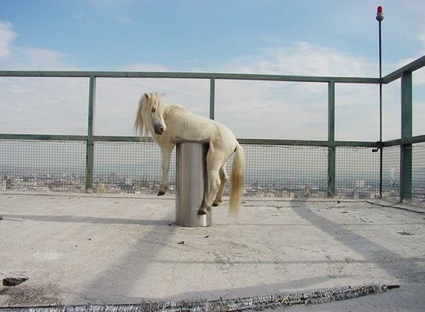 Anri Sala, No barragan no cry, 2002
Anri Sala, No barragan no cry, 2002
Sala is a video artist but somehow, he outgrows the title. He makes films of course but each of them enters in a dialogue with local weather conditions, architecture, history, live performances, sound, language, public participation, etc. Even more interestingly, he seems to play his own works against each other.
Many of Sala’s works are stuck inside my head, even months after having seen them. Let’s start with the first video i saw:
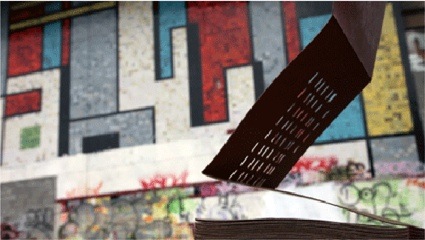 Anri Sala, Le Clash, 2010
Anri Sala, Le Clash, 2010
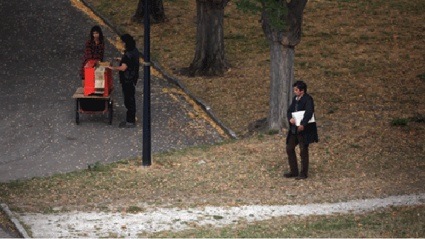 Anri Sala, Le Clash, 2010
Anri Sala, Le Clash, 2010
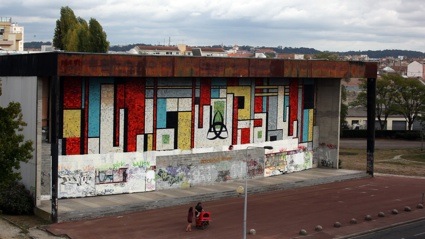 Anri Sala, Le Clash, 2010
Anri Sala, Le Clash, 2010
Anri Sala, recipient of the ABSOLUT ART AWARD 2011, in a film by Thomas Nordanstad
On what looks like the outskirts of a city, a lonely man is slowly playing Should I Stay or Should I Go? on his music box. Somewhere nearby, a man and woman are pushing a music box on a cart that plays the same punk-rock tune.
But there’s a third instrument playing the famous riff of the song: an abandoned concert hall where The Clash played in the early 1980s. Microphones were placed inside the building and the music reverberates with a melancholy that the original tune didn’t have.
Le Clash is an homage to punk-rock song Should I Stay or Should I Go?. It is also almost a reenactment of the concert the group gave in that building in Bordeaux. But the once influential rock and punk venue is derelict, its future uncertain, just like the relationship the song is talking about.
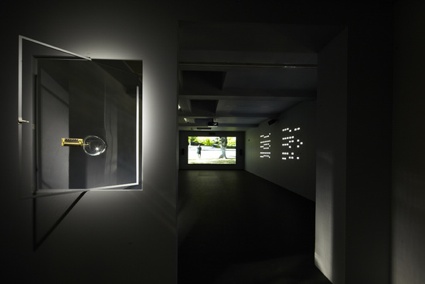 Installation view, Serpentine Gallery, London, 2011. Photo: Sylvain Deleu
Installation view, Serpentine Gallery, London, 2011. Photo: Sylvain Deleu
The show at Serpentine added a further layer to the movie: a glass pane was fitted with a music box that visitors could play. The music was the same as the film’s soundtrack. Sadly, it was broken when i visited the show.
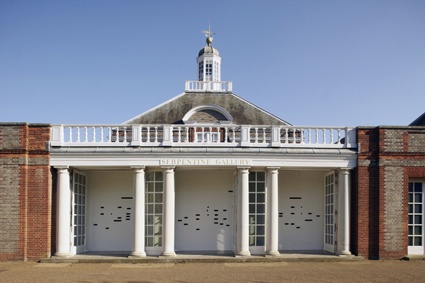 Score, 2011, Installation view, Serpentine Gallery, London, 2011. Photo: Sylvain Deleu
Score, 2011, Installation view, Serpentine Gallery, London, 2011. Photo: Sylvain Deleu
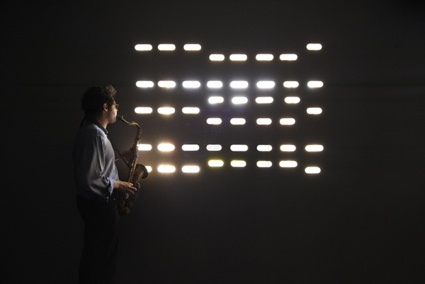 3-2-1, 2011, Performance view, Serpentine Gallery, London, 2011. Photo: Sylvain Deleu
3-2-1, 2011, Performance view, Serpentine Gallery, London, 2011. Photo: Sylvain Deleu
In the site-specific installation, Score, the perforated score used in the barrel organ is part of the architecture of Serpentine gallery. The perforated pattern is carved through walls covering the windows in one of the exhibition spaces, translating sound into a different materiality and creating openings to the park, letting the natural light sneak into the gallery and intertwining the sounds of the park and the sounds of the gallery.
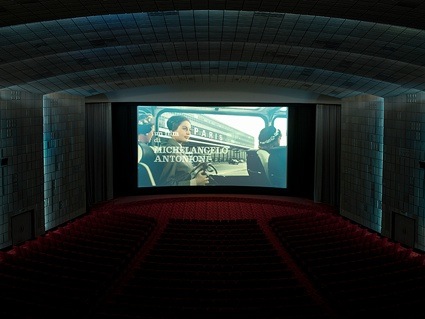 Anri Sala, Thursday 16.07.2009 (Why the Lion Roars) (detail), 2011
Anri Sala, Thursday 16.07.2009 (Why the Lion Roars) (detail), 2011
The lion of Why the Lion Roars is the Metro Goldwyn Mayer one. The lion usually roars to signal the start of a movie, the start of the viewer’s disconnection from the outside world. In Sala’s piece, the animal roars each time the temperature outside of the cinema room goes up or down. The installation is based on a temperature chart made up of several movies. Every degree Celsius represents one movie. A film like Jean-Luc Godard’s Alphaville is associated with cool temperatures, a romantic drama will evoke the Summer. Whenever the temperature outside the exhibition building changes, the movie on display inside changes, too.
If you’re lucky, the temperature outside won’t bulge and you’ll be able to watch Ninotchka till the end. Most of the time, however, only fragments of various length of the films are screened.
Why the Lion Roars is the temperature-cut version of a fiction based on a true story: the weather.
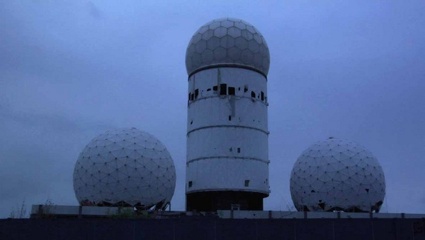 Anri Sala, Answer Me, 2008
Anri Sala, Answer Me, 2008
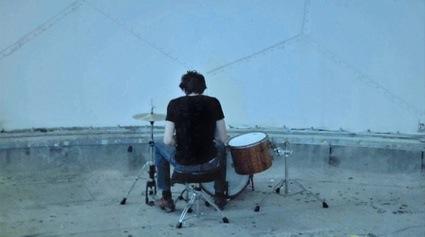 Anri Sala, Answer Me, 2008
Anri Sala, Answer Me, 2008
Answer Me was filmed in Berlin’s listening station Teufelsberg, which means “Devil’s Mountain” in German. It’s actually just a hill but a hill made from the rubble of postwar Berlin and a military-technical college designed by Albert Speer (Adolf Hitler’s chief architect), is buried under it. Later on, the NSA built a listening station on top of the hill to monitor Soviet and East German communications.
In the film, a woman attempts to end a relationship, but the man stubbornly plays the drum to silence her. Her appeal is lost in the spectacular space of the Buckminster Fuller-created geodesic dome and even after the man has stopped playing the drum, the whole drama is deafened by the long echos reverberated in the building structure. But the role of the building doesn’t stop there, the frequencies of the man drumming are amplified by the dome, causing the skin of a drum abandoned next to the frustrated woman to vibrate and its drumsticks to bounce.
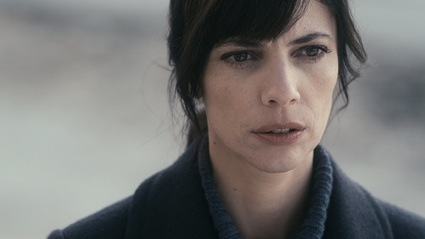 Anri Sala, 1395 Days Without Red, 2011
Anri Sala, 1395 Days Without Red, 2011
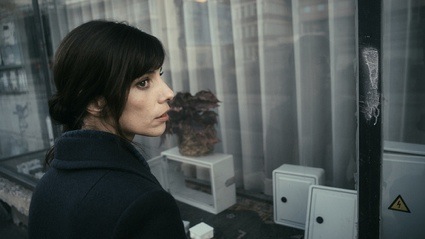 Anri Sala, 1395 Days Without Red, 2011
Anri Sala, 1395 Days Without Red, 2011
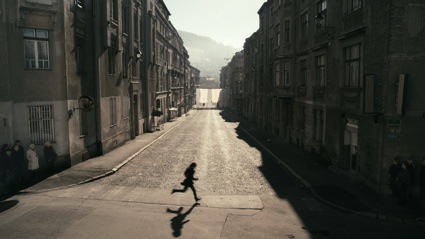 Anri Sala, 1395 Days Without Red, 2011
Anri Sala, 1395 Days Without Red, 2011
1395 Days Without Red, 1395 without being able to wear red or any other bright colour that might be easily spotted by one of the snipers positioned in the hills surrounding Sarajevo during the siege that lasted from May 1992 till February 1996. The film relives the trauma experienced day after day by people caught up in the siege.
The camera follow a woman crossing the city. Each crossing, each alley, each street commands a change of pace. She often has to pause when she feels that the next few meters will expose her to shootings. Then she holds her breath for a moment (i found myself doing the same) and runs till she has reached a safer street. The city’s topography alternates exposure and protection, fear and relief.
As the woman moves through the deserted city, an orchestra rehearses Tchaikovsky’s Symphony No 6, Pathétique elsewhere in the city. She seems to rehearse the music in her head too, using it as the soundtrack of her perilous journey through the city under siege.
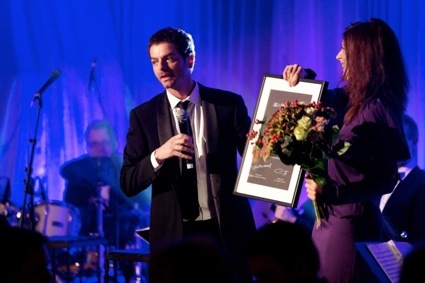 Anri Sala receiving the Absolut Art Award during the price ceremony in Stockholm
Anri Sala receiving the Absolut Art Award during the price ceremony in Stockholm
The ABSOLUT ART AWARD was instituted in 2009 to celebrate the vodka company’s 30 years of creative collaborations (which started by chance during a dinner attended by Andy Warhol i was told.) After giving the award to Keren Cytter in 2009 and Rirkrit Tiravanija in 2010, the third annual ABSOLUT ART AWARD went thus to Anri Sala. He clearly deserved the recognition.
The jury’s citation reads: “Anri Sala’s work offers a unique way of looking at the world that combines reflection on history, memories, and consciousness of the instant, with an absolute awareness of presence and disappearance. He possesses a special talent for precise and subtle displays, and a unique ability to conceive installations and architectural proposals including sound, image, sculpture, film and live performances.”
